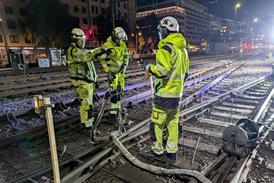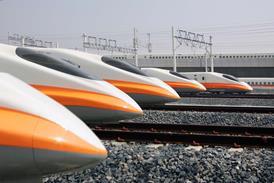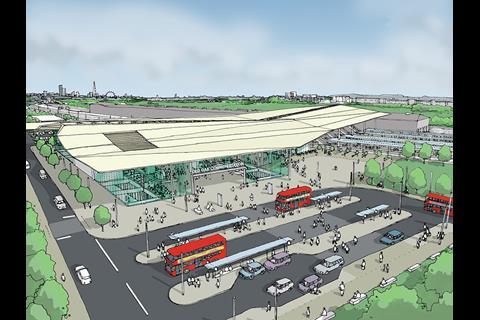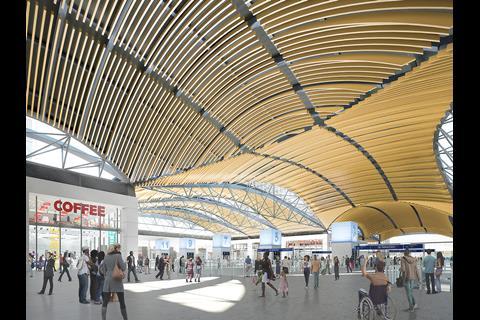UK: ‘It will take a broad coalition involving us, the supply chain and local and national government to deliver this project’, Mark Thurston, Chief Executive of government high speed rail project delivery company HS2 Ltd told the All-Party Parliamentary Rail Group on November 20.
He was updating parliamentarians on progress to date with the planned high speed network linking London with the West Midlands in its 225 km first phase, extending to reach Crewe, Manchester and Leeds in subsequent stages. The target date for completion of the 540 route-km network remains 2033 and the total funding envelope is £55·7bn at 2015 prices. Thurston reported that HS2 Ltd had spent around £4·5bn so far, acknowledging that there was ‘much more work ahead of us than behind us’. He expected that contracts totalling £20bn would have been let by the end of 2019.
Thurston reported that significant progress had already been made, with construction underway at multiple sites including London Euston station. He suggested the project has already secured some ‘under-reported wins’, notably a pan-industry agreement with Network Rail and contractors to create space as part of the Intercity Express Programme for the Old Oak Common station in west London. Final construction contracts worth around £2bn covering the Euston and Old Oak Common stations are to be let ‘within weeks’.
However, Thurston was frank when questioned about progress with the main alignment for Phase I, which has been controversial because it passes through the largely rural Chiltern Hills. Asked about rumours of delays in starting work, he said that the civil works contractual packages for which preferred bidders were named in July 2017 are let in two stages, with the first covering detailed design work.
‘One of the biggest risks in major projects around the world has been proceeding with construction without being absolutely confident that the design can be delivered both in fulfilling the operational requirements of the railway and the budgetary constraints’, he said. ‘We are not there yet in terms of detailed design and I will not rush into the construction phase. Any delay will be for the right reasons.’
Thurston admitted that detailed ground surveys had indicated more problematic conditions than had been anticipated. This concern has been exacerbated by the large amount of tunnelling which had been agreed under the Phase 1 hybrid bill process in parliament. ‘We don’t see as much tunnelling on high speed railways in Europe’, he added.
Emphasising the importance of addressing costs over the operational life of the railway as well as during construction, Thurston said that he did not expect the decision to deploy slab track throughout Phase 1 to be revised. Nevertheless he acknowledged that the government would continue to assess HS2’s costs during its spending review process in the middle of next year.
Parliamentary progress
On the later phases, Thurston said that the parliamentary bill covering Phase 2A between Handsacre and Crewe had ‘good momentum’ and was on course to receive Royal Assent by the end of 2019. High speed services are expected to be running between London and Crewe by the end of 2027, and HS2 Ltd is working with NR to agree a schedule to resignal the busy West Coast Main Line junction before Phase 2A is completed.
The parliamentary process covering Phase 2B, linking the West Midlands and Crewe with Manchester, Leeds and junctions with the existing network near Wigan and York, has been held up to ensure HS2 Ltd’s plans are co-ordinated with proposals for an east-west line being taken forward under the Northern Powerhouse Rail initiative. Thurston said he hoped the Phase 2B bill would receive Royal Assent by the end of 2023 and open by the end of 2033.
Wider benefits
While Thurston recognised that HS2’s ‘transport user benefits are still some years away’, he suggested other tangible positive effects are starting to appear, ‘especially in Birmingham, where HS2 is already proving a catalyst for business and investment, typified by the decision of HSBC bank to relocate there.’
HS2 Ltd has moved its headquarters to Birmingham, with around three-quarters of its 1 600 staff located there. The wider programme is likely to employ 22 000 people at peak construction, Thurston said.
Addressing the burden this places on the supply chain, he suggested that ‘we must attract many more people from different backgrounds to the transport and infrastructure sectors’. Pointing out that HS2 provides a ‘pipeline of opportunities for the long term’, he said the organisation had 3 000 school and college students visit its stand at a skills exhibition in Birmingham earlier in November.
‘There is nothing on HS2 that we have not done before in the UK’, he concluded, ‘it is the scale of the work that makes it a challenge.’










